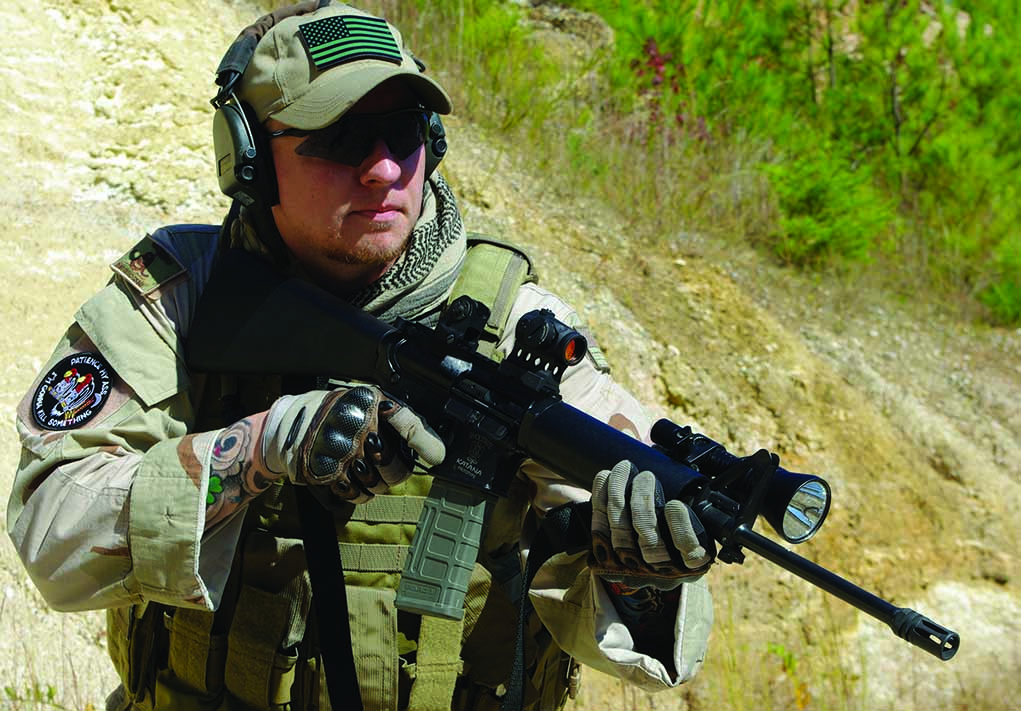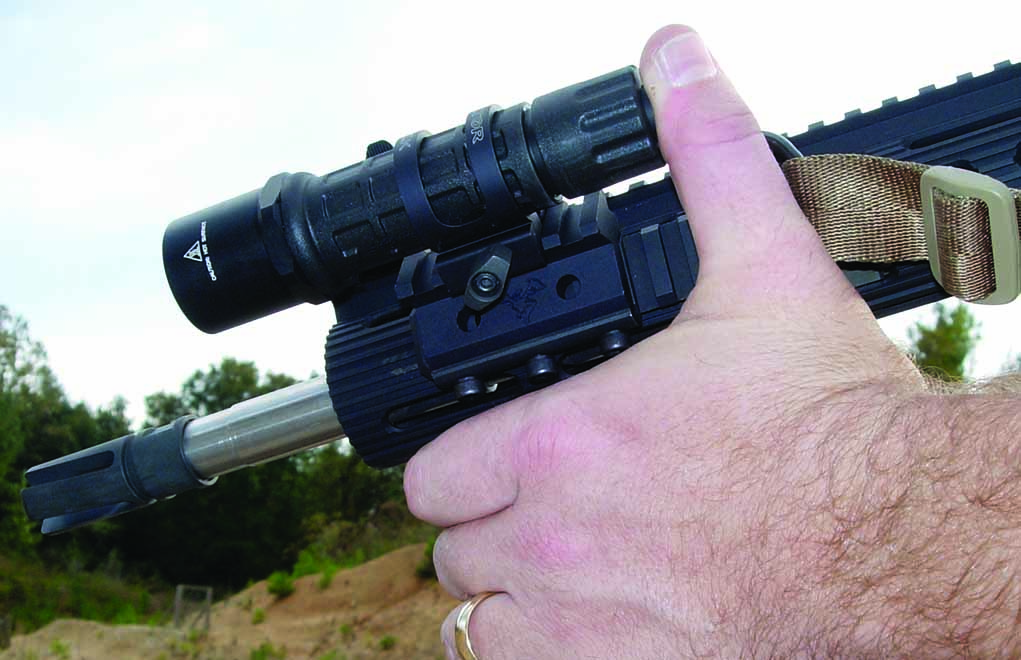
The right combination of a gun light and a handheld flashlight could save your life.
What to look for in a gun light:
- Reliable: Rugged enough to not only handle combat conditions, but also gun's recoil.
- Beam: Provides necessary output and shape to locate and identify threats.
- Compact: Should be small enough not to interfere with operation of gun.
- Switch: Intuitively places for simple operation.
For defensive use, a light on your AR is mandatory. Yes, there are techniques for using a hand-held light — and you should know them — but there’s no reason not to have a flashlight on your AR. A proper light setup has no disadvantages, and it greatly simplifies working in the dark.
Using The Light
The majority of confrontations occur in low-light conditions, and if it’s too dark to identify the possible danger, you’ll have to use a light.

Let’s say you’ve identified a threat — you’re legally and morally justified in shooting — you’re going to need light to shoot accurately, especially when the threat is moving. And when the immediate threat is down or gone, you use the light to scan other areas of concern, ensuring there’s no other danger.
The light is also used to communicate. You see a possible threat or area of concern and need to point out the area to your partner — use the light to mark the area (you can do the same thing with a laser). The light is used to navigate unfamiliar terrain, and when engaging the threat, you’re putting blinding light in their eyes, which is a definite plus. That light comes in handy for a lot of different reasons.
Use the light as little as possible — or as much as necessary. There might be enough ambient light for you to move or search without artificial light. Then, you locate a possible problem and light it up to determine what your response should be. Or, it might be so dark you can’t see, which means using the light during movement to ensure you don’t expose yourself to unseen danger. Regardless of what you’re doing or how much light you’re using, if someone starts shooting at your light you must turn it off and move.
Low-Light Equipment
In the “old” days, attaching a light to your long gun required a lot of creativity. It usually involved some combination of wooden blocks, elastic inner tubes, duct tape and hose clamps. Today, there are a variety of options for mounting a light, regardless of what handguard type your AR has.

I prefer to mount the light at an 11 o’clock position as a right-handed shooter, and I operate the light with the thumb of my support hand. This positions the light in the right location for working to the left or right of cover, or clearing right- or left-turn corners, or working over the top of an object — and it doesn’t block my sights.
To attach the light, you can use a removable mount, which allows you to swap the light from one weapon to another or take it off to use as a hand-held light. Or, it can be a permanent type mount, which clamps on, requiring tools to install or remove.
More AR Articles:
- 7 Affordable 9mm Carbine Options
- Top Options In AR Pistols From Daniel Defense
- Properly Using A Defensive AR-15 From Cover
- Should You Own A Pistol Caliber Carbine?
As for a gun light itself, I’m a big fan of simplicity. Fighting in the dark is complicated enough without complicated equipment. I use lights with a tail-cap-activated button. You press it for momentary activation, or click it for constant light. Lights with high/low/strobe modes that are determined by the button sequence are too complicated.
Training And Practice
So, your light setup is good to go — but you still need a good handheld light standing by, and the skills to use it with the long gun or pistol. If the light the AR light fails, you pull out the handheld and keep working. If you lose the AR or have to transition to the handgun due to a stoppage, it’s again time to use the handheld. The unexpected constantly occurs in fight, so be ready.

Once you get everything set up, it’s time to hit the range. Training is necessary to get an introduction to the proper techniques. There’s a lot more to working in the dark than most people think: There are specific principles and techniques you need to become familiar with. After receiving training you need to practice. Practice — repetition — is when the real learning occurs. You become comfortable with working in the dark, learning how to “paint” with the light or move and shift shadows around to see what they might contain.
Even though you have a light on the AR, it’s still necessary to know how to work with a hand-held light — again with training and then through practice. In the past, all the bulbs used were incandescent, and the two times I need the light on the AR were the two times the bulb blew out. That’s less a problem today with LEDs, but luckily I had a handheld light to flow to and was able to stay plugged in.
The weapon-mounted light makes things simple, and a handheld light offers more versatility. You can have the AR pointing in once direction while using the light to scan in another area.
Another concern is transitions: say you have a light on the AR, but it experiences a stoppage, so you must transition to the pistol. There are techniques to keep using the light on the AR while working with the pistol. When working with two weapons, things become exponentially more complex — but it’s nothing that practice can’t solve.
Final Thoughts

A lot of people have a fear of having to fight in the dark. If you have the proper equipment and skills, there’s nothing to be afraid of. For those who “own the night,” working in the dark can be an advantage — just make sure your gear and skills are up to the challenge.
Editor's Note: This article originally appeared in the August 2018 issue of Gun Digest the Magazine.

Next Step: Get your FREE Printable Target Pack
Enhance your shooting precision with our 62 MOA Targets, perfect for rifles and handguns. Crafted in collaboration with Storm Tactical for accuracy and versatility.
Subscribe to the Gun Digest email newsletter and get your downloadable target pack sent straight to your inbox. Stay updated with the latest firearms info in the industry.

![Best Concealed Carry Guns In 2025 [Field Tested] Wilson Combat EDC X9S 1](https://gundigest.com/wp-content/uploads/Wilson-Combat-EDC-X9S-1-324x160.jpg)


![Best 9mm Carbine: Affordable PCCs [Tested] Ruger Carbine Shooting](https://gundigest.com/wp-content/uploads/Ruger-Carbine-Shooting-100x70.jpg)
![Best AR-15: Top Options Available Today [Field Tested] Harrington and Richardson PSA XM177E2 feature](https://gundigest.com/wp-content/uploads/Harrington-and-Richardson-PSA-XM177E2-feature-100x70.jpg)
